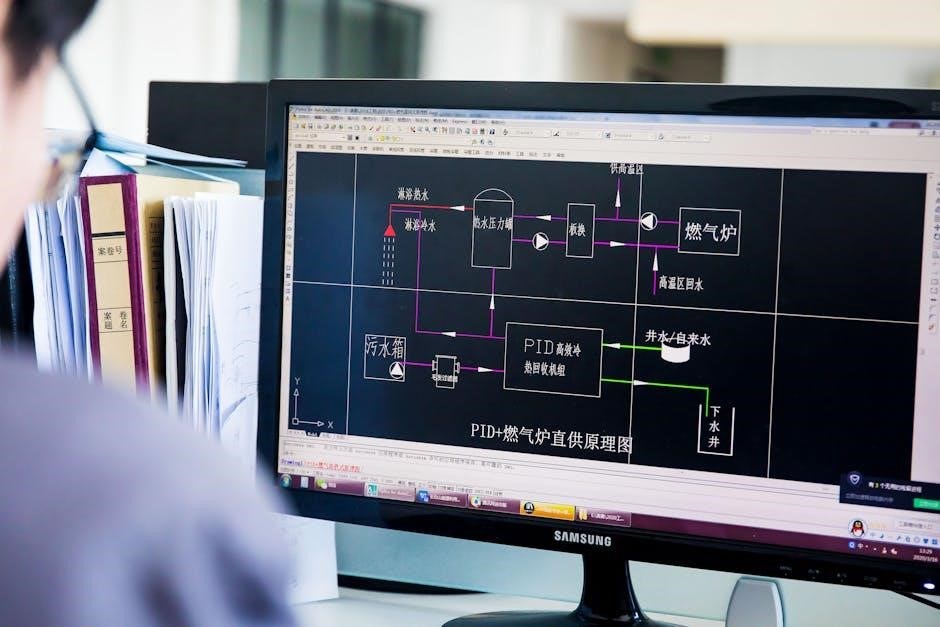Human Design is a self-discovery tool combining astrology, I Ching, Kabbalah, and the chakra system. Your chart, or bodygraph, reveals insights into your personality, strengths, and life path, serving as a visual map for self-awareness and decision-making. It helps you understand your energetic blueprint, guiding you toward alignment with your true self and purpose.
What is Human Design?
Human Design is a self-discovery system blending astrology, the I Ching, Kabbalah, and chakra traditions. It provides a personalized chart, or bodygraph, mapping your energetic makeup. This unique blueprint reveals insights into your personality, strengths, and life path, helping you understand how to align with your true self. By analyzing your birth time, date, and place, Human Design identifies your energy centers, channels, and gates, which influence your behavior and decision-making. It serves as a practical guide for personal growth, offering strategies to navigate life authentically and fulfill your potential. Unlike astrology, Human Design focuses on energetic mechanics, empowering you to make decisions that align with your inner truth and natural flow.
Understanding the Human Design Chart (Bodygraph)
The Human Design Chart, also known as the Bodygraph, is a visual representation of your unique energetic profile. It is a diagram resembling the upper body, with nine energy centers connected by channels. These centers correspond to chakras and represent different aspects of human consciousness, such as emotions, logic, and life force. The Bodygraph is generated using your birth time, date, and place, mapping planetary positions to specific gates and channels. It reveals how energy flows through you, influencing your personality, strengths, and life path. The chart includes variables like incarnation cross, profile, and authority, which further refine your personal blueprint. By interpreting the Bodygraph, you gain insights into your decision-making process, emotional responses, and life strategy, helping you align with your true self and navigate life authentically.
How to Read a Human Design Chart
Reading a Human Design Chart involves understanding energy flow, identifying centers, gates, and channels, and recognizing profiles and authorities. It reveals decision-making strategies and life path alignment.
Step 1: Build the Foundation
Begin by understanding the basic structure of your Human Design Chart. Start with your Type—Manifestor, Generator, Projector, or Reflector—and identify your Authority, which guides decision-making. Locate the red and black lines, representing defined and undefined energies. The Bodygraph’s centers, such as Crown, Self, Sacral, and Root, are key areas. Recognize your Profile, a combination of numbers that influence behavior and life themes. Finally, explore the variables, which refine your energetic profile. This foundational step sets the stage for deeper insights into your design, helping you align with your true self and life’s purpose. Understanding these elements is crucial for accurate interpretation.
Step 2: Understand How Your Energy Flows
Energy in Human Design flows through channels connecting the nine centers in your Bodygraph. Identify how these channels interact, as they reveal your natural life force. Defined centers and channels show consistent energy, while undefined ones indicate areas where you may need external stimulation. Pay attention to your Authority, which dictates how you make decisions—Sacral, Splenic, or Emotional. For Generators and Manifesting Generators, the Sacral response is key. Manifestors rely on life force, while Projectors and Reflectors have unique energetic guidance. Analyze how your energy flows to align with your life strategy, ensuring decisions resonate with your true self. This step helps you harness your energy effectively, fostering harmony and purpose in your daily life.
Step 3: Identify Your Centers, Gates, and Channels
In your Human Design Chart, centers are the nine energy hubs (Crown, Self, Sacral, Solar Plexus, Heart, Throat, Root, Spleen, and Emotional). Gates are the 64 points within these centers, representing specific life themes. Channels connect these gates, forming pathways that define how energy flows through you. Each center, gate, and channel combination reveals unique traits and potential. For example, the Sacral Center is linked to creativity and vitality, while the Throat Center governs communication. Undefined centers indicate areas where you may rely on others’ energy. By mapping these elements, you can understand your strengths, challenges, and how to align with your design. This step is crucial for decoding your personality, decision-making style, and life purpose, offering deep insights into your energetic blueprint.

Key Components of the Human Design Chart
The chart consists of nine energy centers, 64 gates, and 36 channels, which define how energy flows through you. Profiles and variables like incarnation cross and harmony influence behavior.
The Bodygraph and Its Elements
The bodygraph is the visual representation of the Human Design chart, resembling a diagram of the human body. It includes nine energy centers, such as the Crown, Self, Sacral, and Root, each corresponding to specific chakras. These centers are connected by 36 channels, which are pathways through which energy flows. Additionally, there are 64 gates, which are the points where energy enters the centers. The bodygraph also incorporates planetary activations, which are based on the positions of celestial bodies at the time of birth; This intricate map provides insights into personality traits, strengths, and life themes, serving as a guide for personal growth and decision-making.
Gates, Channels, and Their Significance
Gates and channels are fundamental components of the Human Design chart, representing the flow of energy through the bodygraph. Gates are the entry points of energy into the system, while channels are the pathways that connect these gates, forming a network of energy circulation. Each gate and channel combination corresponds to a specific theme or energy pattern, influencing personality, behavior, and potential. Channels connect different energy centers, defining how energy is processed and expressed. The combination of gates and channels determines an individual’s unique profile and life path, offering insights into strengths, challenges, and opportunities for growth. Understanding these elements is crucial for interpreting the chart and aligning with one’s true nature.
Profiles and Their Influence on Behavior
Profiles in Human Design are a key element in understanding individual behavior and life strategies. Derived from the position of the Personality Sun and the Design Earth, profiles are combinations of numbers that provide insights into how a person interacts with the world. Each profile type, such as 1/3, 2/4, or 5/1, carries unique characteristics and tendencies, influencing decision-making, relationships, and overall life approach. For instance, a 1/3 profile may indicate a natural leader with a need for independence and self-expression. Profiles guide individuals in aligning with their authentic selves, offering practical advice on navigating life’s challenges and opportunities. By understanding one’s profile, individuals can harness their strengths and manage potential weaknesses, leading to a more fulfilling and purpose-driven life.
Advanced Concepts in Human Design
Advanced concepts explore deeper layers like variables, authorities, and strategies, offering insights into decision-making and life navigation. These elements refine personal growth and informed choices.
Understanding Authorities and Strategies
In Human Design, authorities and strategies are crucial for aligned decision-making. Authorities, such as Emotional, Sacral, or Splenic, indicate which energy center guides your decisions. For example, Emotional Authority requires waiting 28 days before finalizing choices, allowing clarity to emerge. Strategies, tailored to your type, help navigate life effectively. Manifestors initiate, Generators respond, Projectors guide, and Reflectors mirror. These concepts empower you to align with your true self, fostering authenticity and success. By honoring your authority and strategy, you transcend conditioning and embrace your natural flow, leading to a life of purpose and fulfillment.
Interpreting Variables and Their Impact
Variables in Human Design refine your chart’s insights, offering deeper personalization. These include Profile, Incarnation Cross, and Variable themes, each influencing your life’s purpose and challenges. The Profile, derived from the Sun and Earth positions, reveals how you interact with the world. Incarnation Crosses provide a broader life theme, guiding your soul’s journey. Variables also highlight specific energetic themes, such as resilience or innovation, shaping your experiences; By understanding these variables, you gain clarity on your unique path and how to navigate life’s opportunities and obstacles effectively, aligning with your higher purpose and fostering personal growth and fulfillment.

Practical Application of Human Design Knowledge
Use your Human Design chart to guide decision-making, align with your energy, and embrace your true self, enhancing personal growth and life satisfaction through tailored strategies.
Using Your Chart for Personal Growth
Your Human Design chart offers a profound tool for self-discovery and transformation. By analyzing your unique bodygraph, you can identify strengths, challenges, and life themes tailored to your energetic profile. Understanding your Design Type, Strategy, and Authority provides clarity on how to make decisions aligned with your true self. This insight empowers you to embrace your natural talents and overcome limitations. Practical applications include aligning with your energy flows, trusting your intuition, and fostering emotional well-being. Over time, this awareness enhances self-awareness, confidence, and purpose, guiding you toward a life that reflects your authentic potential. Regular reflection on your chart can deepen your understanding, helping you navigate life’s complexities with greater ease and alignment.

Integrating Human Design into Daily Life
Applying Human Design insights can transform daily routines and decisions. Start by recognizing your energy type and strategy, guiding how you initiate or respond to opportunities. For example, Manifestors should inform before acting, while Generators wait for signs to proceed; Emotional and Sacral Authorities should trust their gut feelings and inner voices, respectively. Align tasks with your energy flows—schedule important activities when your energy peaks. Balance your bodygraph’s centers through practices like meditation to maintain harmony. Honor your profile and incarnation cross by creating supportive environments and relationships. Regular reflection on your chart deepens self-awareness, helping navigate life’s challenges with ease and alignment. This integration fosters a life of authenticity and fulfillment, allowing you to live as your true self.
